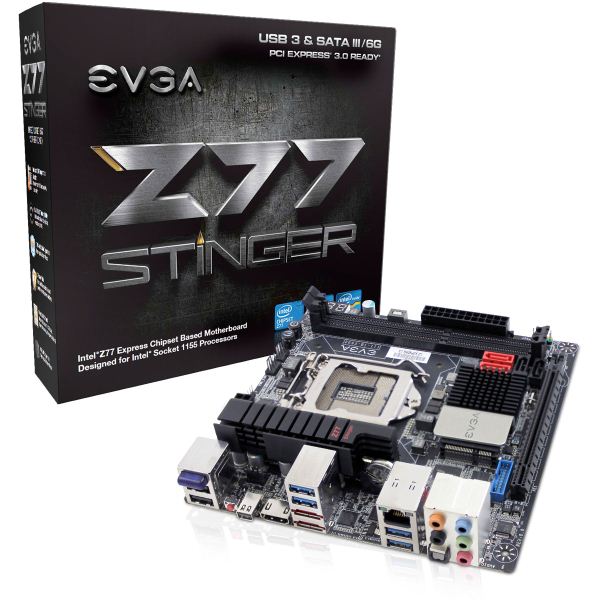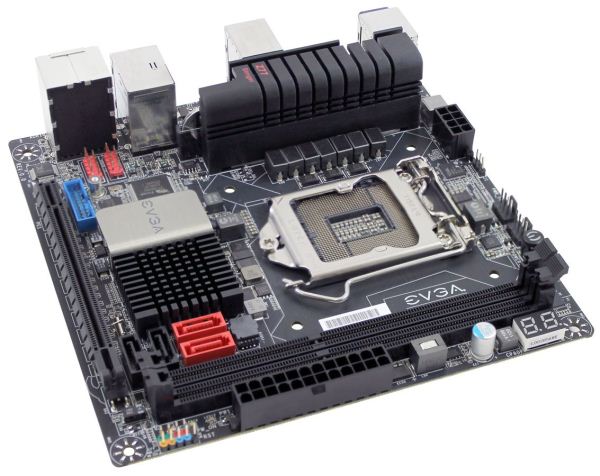Z77 mITX Round-Up: Five of the Best – MSI, Zotac, ASRock, EVGA and ASUS
by Ian Cutress on December 31, 2012 7:00 AM EST- Posted in
- Motherboards
- MSI
- ASRock
- EVGA
- ZOTAC
- Asus
- Ivy Bridge
- Z77
- mITX
EVGA Z77 Stinger Conclusion
EVGA has a reputation for being something a little special. The fan base is loyal, and despite the size of the company they have upgrade paths for their hardware (the EVGA Step-Up program) and deal with all RMA requests personally rather than through the reseller. The forums are always full of posts, and a lot of members also contribute their hardware and spare time for distributed computing projects such as Folding@Home or BOINC. EVGA’s main product line is in NVIDIA graphics cards, and their high end models, although expensive, are often pre-overclocked and sell like hot cakes. They hire top well-known overclockers to showcase how capable their products can be in the right hands.
The motherboard side is less lucrative. EVGA’s market share in the motherboard segment is tiny compared to ASUS and Gigabyte, and still small compared to MSI and Biostar. For a given chipset they rarely release more than three motherboards (e.g. X79 SLI, X79 FTW, X79 Classified or Z77 FTW, Z77 Stinger), and those motherboards are often late to launch and come with some easy-to-spot issues. Every so often they come out with something special (EVGA SR-2) which is hard to ignore.
When I approached EVGA to request a review sample of the Stinger, I had seen the leaked images online and it looked like a good product. I even posted them on AnandTech. When the sample came through the door and I saw the price, I was a little taken aback. $200 puts it as the most expensive mITX board on the market, even more so than the ASUS P8Z77-I Deluxe which uses a daughter PCB for power delivery. At the $200 price point, it was going to be a tough sell to all but EVGA enthusiasts.
For the green we get some ‘extra’ compared to most other mITX boards on the market. This means an Intel NIC, a total of six USB 3.0 ports, two more SATA 6 Gbps (in the form of eSATA), the socket placed at the top rather than the bottom, three fan headers and power/reset buttons with a debug LED. Unfortunately, most of the cheaper boards offer better audio than the Realtek ALC889, they offer a WiFi module included in the product, more video output connectivity, some offer an mSATA, a mini-PCIe, and substantially more IO on the back panel.
BIOS wise EVGA is at a disadvantage due to the size of the company, but the lack of XMP options in the release BIOS does not help much. Despite the two years since graphical BIOSes came into force, I have been told that an implementation may be coming with Haswell (and hopefully with a print screen option). The software side with EVGA also falls against the same hurdle, with only one utility that offers little – no BIOS update feature, no fan control, no network control, no power delivery control.
In terms of performance, all is right with the EVGA Z77 Stinger. We got a fair representation across the range of benchmarks with no out-of-the-ordinary bursts or dips apart from the 192 kHz audio test fail due to the ALC889.
As mentioned before, the EVGA Z77 Stinger is a hard sell, and at $200 it is not really doing itself any favors when compared side-by-side with the competition. There are motherboards out there that offer a lot more in terms of usability and experience, but with EVGA we do get that Step-Up program and direct dealing with RMA. Are these differences worth the $50-$55 jump up from an ASRock or an MSI? If the Z77 Stinger was around the same price as the Zotac, it might be worth a punt.












54 Comments
View All Comments
Bullwinkle J Moose - Monday, December 31, 2012 - link
Hey yeah, Ian haz a good pointThat Crappy Gigabyte H61n-USB3 doesn't have Chipset USB3
But it does however boot just fine to a USB3 Windows to go drive at USB3 speeds
It also boots to Linux and XP due to the Non-Locked down Bios so we wouldn't want that either would we
and it takes a full 9 seconds to boot XP compared to the super de duper fast 7 second Windows 8
So we should spend more money and get locked into a closed system
After all, that is the future!
Limitations are fun so be happy as we lock down the Internet as well
After all, there are scarey Monsters out there
A man has to know his limitations
Clint Eastwood
Bullwinkle J Moose - Monday, December 31, 2012 - link
Ian haz a good point about the memory tooThat Gigabyte H61 board only takes up to 16GB of RAM
How much do these Z77 boards take by the way?
Was it this site or Maximum PC where the reviewers stated that in everyday use, you will notice no difference in speed between Sata 2 & 3 when you are using the latest and greatest SSD so I probably don't need the RAID capability on my H61 either
Keep up the good work Ian
Death666Angel - Wednesday, January 2, 2013 - link
It seems that someone just discovered sarcasm. Good for you!mczak - Monday, December 31, 2012 - link
H61 is not limited to one single sided DIMM per channel, double sided are just fine. It only accepts one per channel (at least it's specced that way) but since none of these mini-ITX boards have more than two memory slots this wouldn't matter at all here (max memory is still 2x8GB regardless).Frankly I'm not sure losing PCIe 3.0 is a big deal with mini-itx boards in any case but either way it isn't exactly true there are h61 boards supposedly supporting this (as it's got nothing to do with the chipset anyway all the pcie 3.0 signals coming directly from the cpu, though it would require bios support).
This leaves us with losing SATA 6 Gbps - this might indeed make some minimal difference in real world, provided you use a SSD and not a HD.
The major point imho (aside from overclocking) would be missing USB 3.0, which obviously makes a big difference when using external harddisks etc. Granted that could be done with separate usb controller but probably not a good idea since space is limited.
H61 IIRC also will lose the possibility of using 3 display outputs simultaneously. Maybe something like H77 would make more sense for mini-ITX as it pretty much only loses overclocking (plus the ability to split the 16 x pcie 3.0 lanes into 2x8 though I guess this has nothing to do with the chipset itself really, but in any case it won't be missed on mini-itx). So if you don't want to overclock, you wouldn't miss anything at all with H77 on a mini-itx board.
Etern205 - Saturday, January 5, 2013 - link
I also notice that as well, most sites will only review Z77 mITX boards instead of H61 or H77. Not all will need a Z77, Z77 is mostly for enthusiast or for those who are into the technical stuffs. For the average Joe or Jane any mITX board will do. If you tell them it's H61 or Z77, they probably won't care too much on the difference.piroroadkill - Wednesday, January 2, 2013 - link
You can't easily upgrade the chipset later. With a small up-front investment, you get the full feature set, and why not?Bullwinkle J Moose - Sunday, January 6, 2013 - link
Oh Boo Hoo, I can't easily upgrade to an overclocking chipset or void the warranties of my hardware componentsI am just stuck with a totally stable system
Boo Hoo
How can I possibly break this ?
What has the World become ?
Poor me
Boo Hoo
Bullwinkle J Moose - Sunday, January 6, 2013 - link
Why not?Because the H61 is exactly what I wanted
and anything else is NOT !
can you hear me now?
EVGA KINGPIN - Friday, November 19, 2021 - link
I still use my Z77 FTW board , have had it running without turning it off since 2015. evga is the best ,also my EVGA GTX 980 KINGPIN is still running strong,,,thanks EVGA for quality products, JRTsherlockwing - Monday, December 31, 2012 - link
Where is the Gigabyte?